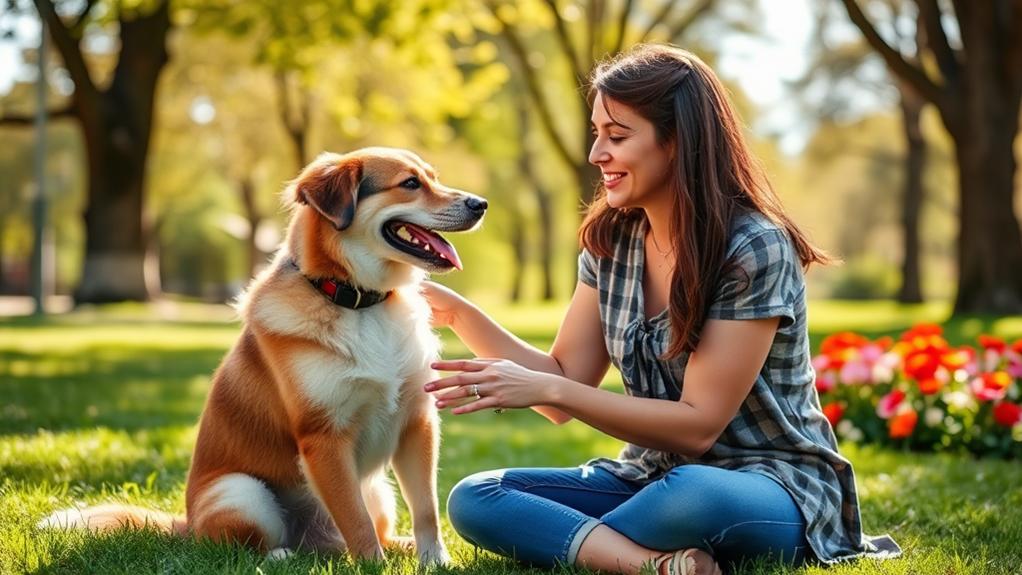To master basic obedience training for your dog, start by teaching essential commands like "Sit," "Stay," and "Come." Use positive reinforcement such as treats and praise to encourage desired behaviors. Keep training sessions short and consistent, ideally 5-10 minutes a few times daily. Minimize distractions by training in a calm environment, and gradually introduce more challenging scenarios. Avoid common mistakes like inconsistency in commands and delayed rewards. Don't forget to socialize your dog early to enhance their confidence. By incorporating these techniques, you'll strengthen your bond with your dog, setting the stage for even more effective training strategies.
Understanding Obedience Training
When it comes to training your dog, understanding obedience training is essential for building a strong bond and ensuring good behavior. This type of training focuses on teaching your dog to respond consistently to commands, which enhances communication between you and your furry friend. By establishing clear expectations, you create a stable environment where your dog can thrive.
Obedience training isn't just about commands; it's about fostering mutual respect. When you train your dog, you're not only teaching them what to do, but you're also reinforcing your role as a leader. This helps your dog feel secure and confident, knowing they have guidance.
Start by creating a positive atmosphere during training sessions. Use treats and praise to motivate your dog and make learning enjoyable. Keep sessions short and engaging to maintain their focus. Remember, patience is key; every dog learns at their own pace.
You'll find that a solid foundation in obedience training leads to better behavior in various situations. As you progress, you'll notice your dog becoming more responsive and attentive, strengthening your bond and enhancing your life together.
Essential Commands to Teach

Teaching your dog essential commands is a fundamental part of obedience training that reinforces your communication and strengthens your relationship. These commands create a foundation for good behavior and help keep your dog safe. Start with the basics: "Sit," "Stay," "Come," "Down," and "Leave It."
The "Sit" command helps your dog learn to be calm and attentive. When you say "Stay," you teach them self-control, allowing you to manage their movements. "Come" is vital for recall, ensuring your dog returns to you when called. The "Down" command encourages your dog to settle and relax, making it easier to control their energy. Finally, "Leave It" is imperative for preventing your dog from picking up something harmful or distracting.
Practice these commands consistently in different environments to reinforce learning. Always use clear, firm commands, and be patient—every dog learns at their own pace. As you master these essential commands, you'll build a stronger bond with your dog and enhance their overall behavior. Your commitment to training will pay off, making your dog a well-mannered companion that you can enjoy in any situation.
Positive Reinforcement Techniques

Positive reinforcement techniques are pivotal for effective dog training, helping to encourage desired behaviors while building trust between you and your furry friend. By rewarding your dog immediately after they perform a command correctly, you create a positive association that makes them more likely to repeat the behavior.
Start with treats, as they're often the most motivating reward. Choose small, tasty morsels that your dog loves. When your dog sits on command, for example, give them a treat right away, along with enthusiastic praise. Use a happy tone to reinforce their good behavior; dogs respond well to your energy.
You can also use toys or playtime as rewards. If your dog enjoys fetch, toss a ball after they've successfully followed a command. This keeps training fun and engaging.
Consistency is crucial; everyone in your household uses the same commands and rewards. This prevents confusion for your dog and strengthens their learning.
Lastly, keep training sessions short and enjoyable. If your dog becomes bored or frustrated, it's acceptable to take a break. Remember, the goal is to foster a positive learning environment where your dog feels encouraged and motivated to obey.
Setting a Training Schedule

Establishing a consistent training schedule is key to reinforcing the positive behaviors you've been encouraging through rewards. By setting aside specific times each day for training, you create a routine that both you and your dog can rely on. Aim for short, focused sessions—about 5 to 10 minutes—two to three times a day. This keeps your dog engaged and prevents fatigue.
Choose a time when your dog is alert and receptive, like after a walk or playtime. Consistency in timing helps your dog anticipate training, making them more inclined to participate. Mark your training sessions on a calendar or set reminders on your phone to maintain your schedule.
Additionally, think about your own schedule. Training should fit seamlessly into your daily life without adding stress. If mornings are hectic, consider training in the evening when you're more relaxed. Remember, the goal is to make training an enjoyable experience for both of you.
Managing Distractions During Training

While training your dog, managing distractions is essential for maintaining focus and ensuring effective learning. Distractions can hinder your dog's ability to respond to commands, so it's paramount to create an environment where they can concentrate.
Start by identifying common distractions in your training area. You might encounter things like noises, other pets, or even people passing by. To help your dog focus, you can use the following strategies:
| Strategy | Description |
|---|---|
| Gradual exposure | Slowly introduce distractions during training sessions, starting with minimal ones. |
| Controlled environment | Train in a quiet space and gradually move to busier areas as your dog improves. |
| Reward good behavior | Reinforce your dog's focus by rewarding them when they ignore distractions. |
Common Training Mistakes

Many dog owners make common training mistakes that can hinder their pet's progress. One of the biggest errors is inconsistency. If you use different commands or rewards, your dog will get confused about what you expect. Stick to one command for each behavior and guarantee everyone in the household is on the same page.
Another mistake is neglecting to reward good behavior immediately. Timing is indispensable in dog training. If you wait too long to give a treat or praise, your dog may not connect the reward with the behavior you want to reinforce. Always reward right after the desired action.
Additionally, many owners fail to set realistic expectations. Training takes time, and puppies, in particular, have short attention spans. Keep training sessions short—around 5 to 10 minutes—and be patient as your dog learns.
Socializing Your Dog

Socialization is an essential part of your dog's training journey. It helps your pup learn how to interact with different people, animals, and environments. Begin this process early, ideally when your dog is a puppy, but older dogs can benefit too. Introduce your dog to a variety of experiences, such as meeting new people, visiting parks, and encountering other dogs.
Start with controlled settings where your dog feels safe and secure. Encourage positive interactions by rewarding your dog with treats and praise when they behave calmly. Be patient; it's normal for some dogs to be shy or fearful at first.
Gradually expose your dog to busier environments to build their confidence. Keep sessions short and enjoyable to prevent overwhelming them. Remember, the goal is to create positive associations, so avoid forcing your dog into uncomfortable situations.
Regular socialization helps your dog develop good manners and reduces behavioral issues down the line. The more experiences you provide, the more well-adjusted your dog will become. Make socialization a fun adventure, and you'll foster a happy, confident companion ready to face the world.
Progress Tracking and Adjustments

Tracking your dog's progress is essential for effective training and ensuring you're meeting their needs. By keeping a record of your sessions, you can identify what works and what doesn't. Start by noting down your dog's responses to commands. Are they improving, or do they seem confused? This helps you adjust your training approach accordingly.
If your dog struggles with a particular command, consider changing your method. For instance, if your dog isn't responding to "sit," try using treats or a different tone of voice. You can also break the command down into smaller steps. Celebrate small victories to keep your dog motivated.
Regularly assess the environment too. Distractions can hinder progress, so practice in different settings. If your dog performs well in a quiet room but struggles at the park, gradually introduce distractions during training sessions.
Lastly, don't hesitate to revisit previous commands. Reinforcement helps solidify learning. Adjust your expectations based on your dog's pace and personality. You're in this together, so be patient and flexible. Remember, consistent tracking and adjustments lead to a more effective training experience for both you and your furry friend.
Building a Lasting Bond

To build a lasting bond with your dog, focus on spending quality time together. Engaging in activities that both you and your dog enjoy will deepen your connection and foster trust. Here are some ways to strengthen that bond:
- Go for daily walks or hikes to explore new environments.
- Play interactive games like fetch or tug-of-war to encourage teamwork.
- Try training sessions where you teach new tricks or reinforce commands.
- Create a relaxing routine, like cuddling or grooming, to enhance comfort.
- Attend dog-friendly events or classes to socialize and learn together.
Consistency is key. Make sure you're present and attentive, showing your dog that they're a priority in your life. Remember, it's not just about the activities but also about how you engage during these moments. Use positive reinforcement, praise, and affection to encourage your dog. This approach not only builds obedience but also strengthens your relationship. Over time, you'll notice your dog responding to you with more trust and affection. Enjoy the journey of discovering what works best for both of you, and cherish the unique bond that develops as you share experiences.
Conclusion
Mastering basic obedience training isn't just about commands; it's about building a strong bond with your dog. By understanding key techniques and consistently applying them, you'll see progress and a happier pup. Remember to stay patient and positive, adjusting your approach as needed. With dedication and love, you'll transform your dog into a well-behaved companion. Keep practicing, stay committed, and enjoy the rewarding journey of training together!



